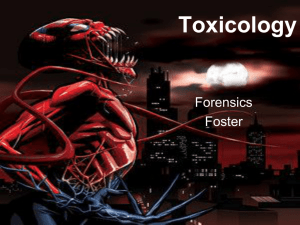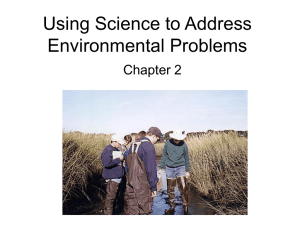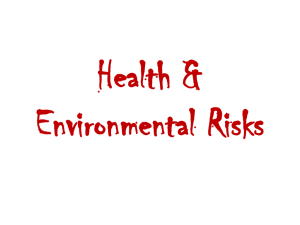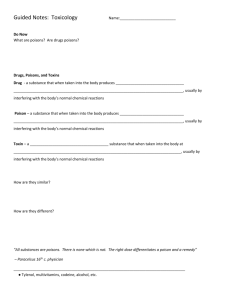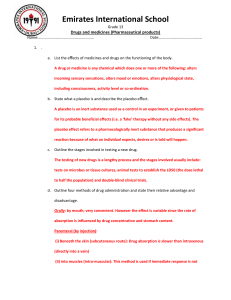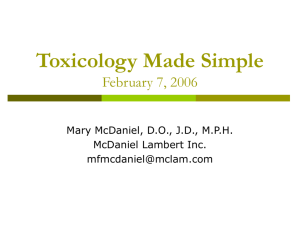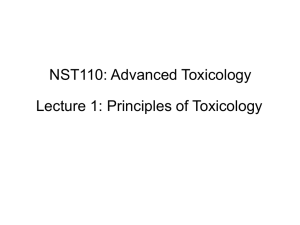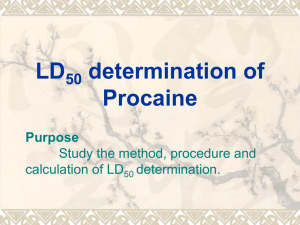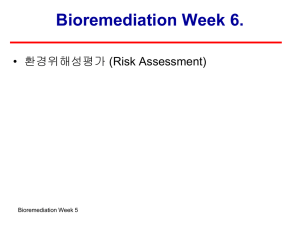Lethal Dose LD50: Toxicology Presentation
advertisement
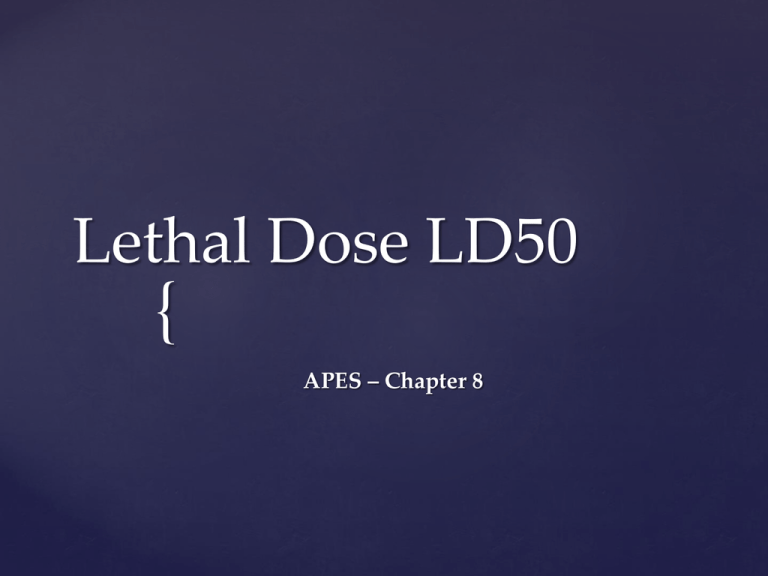
Lethal Dose LD50
{
APES – Chapter 8
Toxicology is the
study of the adverse
physico-chemical
effects of chemical,
physical or biological
agents on living
organisms and the
ecosystem.
Includes the
prevention and
treatment of disease.
Toxicology
Toxicology, ancient in
practice, came to be
known simplistically as
the science of poisons.
“The dose makes the poison.”– almost everything is toxic at some level.
(According to Swiss scientist Paracelsus 500 years ago.)
How do you determine if a drug or chemical is safe to use…lab testing!
Laboratory Investigations to
Measure Toxicity
Animal Studies
Populations of lab animals usually rodents
Measured doses under controlled conditions
Takes two to five years
Costs $200,000 to $2,000,000 per substance
Newer methods
Laboratory Investigations
Newer methods
Bacteria (Transgenic experiments)
Cell and tissue culture
Appropriate tissue
Stem cells
Chicken egg membrane
Laboratory Investigations
Love Canal Part I
Love Canal Part 2
Biohazards / Superfund
Site
Epidemiology is the study of distribution and
determinants of health problems in specified
populations.
a) applying the learned information to control
the health problems.
It is the scientific method of problem solving
disease—epidemiologists, laboratory scientists,
statisticians,
physicians and other health care providers, and
public health.
Epidemiology
Determine severity of health concern…is it an
epidemic or an outbreak?
Identify the cause.
Identify if it is a small cluster or larger
population
Geographic location(s)
Criteria used to measure
concerns
Epidemic--refers to a
contagious, infectious
or viral illness that
spreads to many
people in one
geographic region that
occurs in excess of the
numbers of cases that
would usually be
expected.
Pandemic refers to a
contagious, infectious
or viral illness that
spreads, and may
include millions of
people in many areas
across the globe,
according to the World
Health Organization's
description.
Laboratory testing on different drugs or
chemicals are done by looking at a dose
response curve.
To determine the toxicity of a chemical, look at
dose to which 50% of the test population is
sensitive.
Which dose is right?
Percentage of population killed by a given dose
100
In case of lethal
dose (LD), this is
called LD50.
75
50
25
LD
0
2
4
6
8
50
10
12
Dose (hypothetical units)
14
16
Fig. 8.16, p. 171
LD50 =individual dose
required to kill 50% of test
population (e.g., rats, fish,
mice, cockroaches).
Standard to compare relative
toxicities of chemicals.
The lower the LD50 dose, the
more toxic the pesticide.
A pesticide with an LD50
value of 10 mg/kg is 10 times
more toxic than a pesticide
with an LD50 of 100 mg/kg
LD-50 Dose Response
Number of individuals affected
Different sensitivities
to toxin to specific
populations.
Very
Sensitive
0
Majority
of Average
Population
20
40
low
Low
Sensitivity
Sensitivity
60
80
Dose (hypothetical units)
Fig. 8.15, p. 171
Validity Challenged
Human physiology is different
Different species react different to same toxins
Mice die with aspirin
Species can be selected depending on physiological area
Pigs circulatory very similar to humans
Laboratory Investigations
Toxicity
Toxicity
LD50
Lethal Dose
Examples
Super
< 0.01
less than 1 drop
dioxin, botulism
mushrooms
<5
less than 7 drops
heroin, nicotine
Very
5-50
7 drops to 1 tsp.
morphine, codeine
Toxic
50-500
1 tsp.
DDT, H2SO4, Caffeine
Moderate
500-5K
1 oz.-1 pt.
aspirin, wood alcohol
Slightly
5K-15K
1 pt.
>15K
>1qt.
Extreme
Non-Toxic
ethyl alcohol, soaps
water, table sugar
(LD50 measured in mg/kg of body weight)
Why so little is known of toxicity
Only 10% of at least 75,000 commercial chemicals have been screened
~2% determined to be carcinogen, teratogen or mutagen
>1000 new synthetic chemicals added per year
>99.5% of US commercial chemicals are NOT regulated
Nonlinear
dose-response
Linear
dose-response
Linear
dose-response
Effect
Effect
Nonlinear
dose-response
Dose-Response Curves
Threshold
level
Dose
No threshold
Dose
Threshold
Fig. 16.6, p. 401
